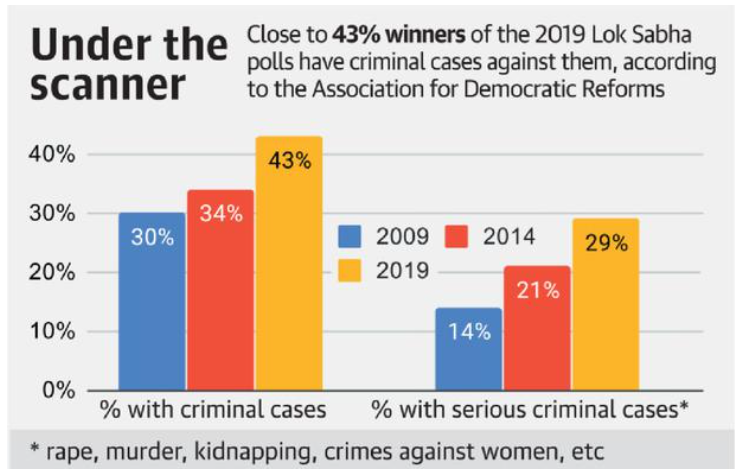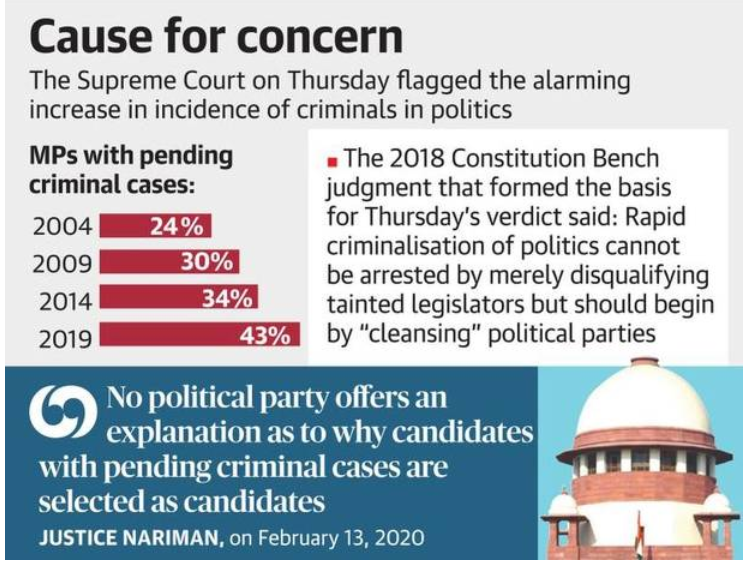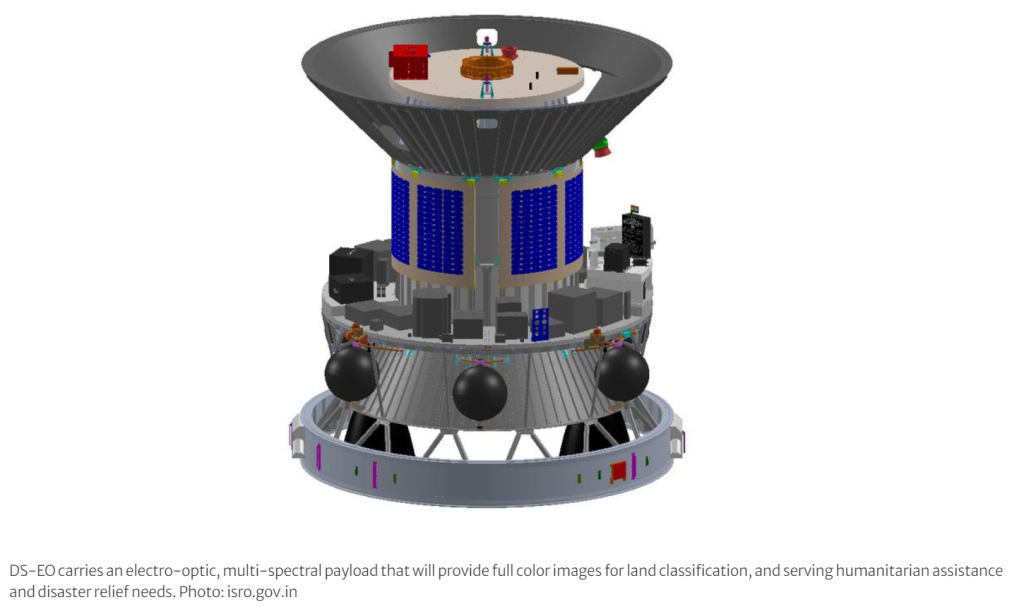CONTENTS
- Transparency in Candidate Disclosure
- ISRO’s ‘Zero Orbital Debris’ Milestone
Transparency in Candidate Disclosure
Context:
Recent developments in Indian electoral procedures include a Supreme Court ruling stating that candidates are not obligated to disclose every minor detail in their election affidavits unless it holds significant relevance. Additionally, the Election Commission of India (EC) has requested the Central Board of Direct Taxes to authenticate the income declaration made by the BJP nominee from Thiruvananthapuram.
Relevance:
GS-2
- Parliament
- State Legislature
- Statutory Bodies
- Constitutional Bodies
- Government Policies and Interventions
- Executive
- Judiciary
Mains Question:
How has the Supreme Court addressed concerns about candidates with serious criminal charges contesting elections? Can the reforms by the Law Commission and Election Commission help in addressing such concerns? (15 Marks, 250 Words).
Representation of the People Act, 1951 (RP Act)- Important Sections in this Regard:
- According to Section 33 of the Representation of the People Act, 1951 (RP Act) along with rule 4A of election regulations, all candidates contesting in elections must submit their nomination papers accompanied by an affidavit in a specified format.
- In the case of Association of Democratic Reforms (ADR) Vs Union of India (2002), the Supreme Court ruled that voters possess the right to be informed about a candidate’s criminal history, income, assets, educational qualifications, and those of their dependents.
- As a result, Section 33A was added to the RP Act, necessitating the disclosure of criminal antecedents in the election affidavit.
- Furthermore, Section 125A of the RP Act stipulates that failure to provide necessary information, furnishing false information, or concealing any details in the nomination papers or affidavit could lead to imprisonment for up to six months, a fine, or both.
Key Concerns:
- In a recent instance, an independent candidate from Arunachal Pradesh omitted to declare three vehicles as assets in his election affidavit during the 2019 Assembly election. Consequently, the Gauhati High Court nullified his election.
- However, the Supreme Court overturned this ruling, asserting that failure to disclose immaterial or non-substantial information cannot be construed as an attempt to unduly influence voters.
- In the case of the BJP nominee from Thiruvananthapuram, the allegation revolves around the purported concealment of income and significant assets in his election affidavit, potentially influencing voter decisions.
Candidates with Severe Criminal Charges:
- A more pressing issue pertains to candidates with severe criminal charges participating in elections. Some candidates evaded the requirements of rule 4A by leaving certain sections blank or submitting incomplete affidavits.
- This issue necessitated a court order in Resurgence India Vs EC (2013) to ensure comprehensive completion of all sections. According to a report by ADR, 19% of candidates in the 2019 Lok Sabha election faced charges of rape, murder, or kidnapping.

- The Law Commission, in its 244th report titled ‘Electoral Disqualifications’ (2014), and the Election Commission (EC), in its memorandum on ‘Electoral reforms’ submitted in 2016, put forward specific recommendations.
- Firstly, they proposed that a conviction for submitting a false affidavit should result in a minimum punishment of two years imprisonment and be grounds for disqualification.
- Secondly, they suggested that trials in such cases should be expedited, conducted on a day-to-day basis.
- Lastly, individuals charged with offenses punishable by imprisonment of at least five years should be barred from contesting in elections if the case is filed at least six months prior to the relevant election.
- In the case of Public Interest Foundation Vs Union of India (2018), the Supreme Court mandated that candidates and political parties must issue a declaration regarding their criminal history at least three times before the election, through advertisements in local newspapers and electronic media.

Conclusion:
Although there is concern that prohibiting candidates facing chargesheets from contesting elections might be exploited by incumbent parties, other recommendations, such as enhancing penalties for submitting false affidavits and making it a disqualification criterion, should be put into effect. The Supreme Court’s directive to widely publicize criminal records should also be rigorously enforced. This would empower voters to make informed decisions when casting their votes.
ISRO’s ‘Zero Orbital Debris’ Milestone
Context:
The Indian Space Research Organisation (ISRO) announced that its PSLV-C58/XPoSat mission has resulted in minimal debris left in Earth’s orbit. ISRO clarified that the final stage of the Polar Satellite Launch Vehicle (PSLV) utilized in the mission was repurposed into what’s known as the PSLV Orbital Experimental Module-3 (POEM-3). Instead of lingering in orbit after completing its mission, the stage was converted into a sort of orbital station.
Relevance:
GS-3- Space Technology
Mains Question:
How did ISRO ensure practically zero debris left in earth orbit after the PSLV-C58/XPoSat mission? Discuss the purpose and function of the PSLV Orbital Experimental Module-3 (POEM-3) in this regard? (15 Marks, 250 Words).
Further Explanation:
- ISRO further explained that following the successful injection of all satellites into their designated orbits, the fourth stage of the PSLV was transformed into the POEM-3.
- Subsequently, it was deorbited from 650 km to 350 km altitude, making it more prone to gravitational pull towards Earth and eventual incineration in the atmosphere.
- Additionally, ISRO stated that they “passivated the stage,” meaning they purged its fuel to prevent any explosion that could have resulted in the dispersion of small debris into orbit.
More on POEM:

- POEM, developed by the Vikram Sarabhai Space Centre (VSSC) as a cost-effective space platform, utilizes the spent fourth stage of a PSLV rocket as an orbital platform.
- Initially employed in the PSLV-C53 mission in June 2022, POEM orbits the Earth to conduct in-orbit scientific experiments with various payloads onboard.
- POEM is equipped with solar panels mounted on the rocket’s fourth stage fuel tank, alongside a lithium-ion battery.
- It incorporates a navigation, guidance, and control (NGC) system to maintain its altitude, along with helium control thrusters.
- The NGC system includes four Sun sensors, a magnetometer, and gyroscopes, and communicates with ISRO’s NavIC satellite constellation for navigation.
- Furthermore, POEM features a telecommand system for ground station communication.
- ISRO initially demonstrated the reusability of its spent fourth stage rocket in the PSLV C-44 mission back in 2019.
- Following the successful deployment of satellites into their designated orbits, the fourth stage, carrying a student payload named Kalamsat-V2, was maneuvered to a higher circular orbit of 443 km, where it remained to fulfill the payload’s requirements.
Accomplishments of POEM-3:
- ISRO launched the PSLV C-58 mission from the Satish Dhawan Space Centre in Sriharikota on January 1.
- After deploying the XPoSat satellite into its intended orbit at 650 km altitude, the fourth stage, now designated as POEM-3, was transitioned to a circular orbit at a lower altitude of 350 km.
- The closer a satellite orbits Earth, the greater the atmospheric drag it experiences, necessitating more energy to maintain its orbit.
- POEM-3 carried nine payloads, including two from VSSC and Bellatrix Aerospace Pvt Ltd each, and one from startups such as TakeMe2Space, Inspecity Space Labs Pvt Ltd., Dhruva Space, as well as from LBS Institute of Technology, KJ Somaiya Institute of Technology, and ISRO’s Physics Research Laboratory in Ahmedabad.
- By its 25th day, POEM-3 had completed 400 orbits around the Earth. At this juncture, the payloads were activated to conduct their experiments.
- ARKA200, RUDRA, and LEAP-TD successfully carried out their respective experiments, while data from WeSAT, RSEM, and DEX were collected after each orbit for further analysis on the ground.
- Two fuel cells from VSSC demonstrated their power generation capability. By January 27, 2024, all of POEM-3’s payload objectives had been achieved.
- For a period of two months thereafter, POEM-3 underwent preparations for its re-entry into Earth’s atmosphere.
- ISRO monitored its trajectory using its Telemetry, Tracking, and Command Network stations located in Bengaluru, Lucknow, Mauritius, Sriharikota, Port Blair, Thiruvananthapuram, Brunei, and Biak (Indonesia), along with the Multi-Object Tracking Radar (MOTR) at Sriharikota. On March 21, POEM-3 made its re-entry into the Earth’s atmosphere, reaching its fiery demise.
Concern of Space Debris:
- The escalation in satellite deployment around the Earth has intensified concerns about space debris.
- Primarily comprising remnants of spacecraft, rockets, defunct satellites, and fragments from objects deteriorated explosively, space debris orbits the Earth at velocities reaching up to 27,000 km/hr. Given their abundance and momentum, they pose a significant hazard to various space assets.
- The low Earth orbit (LEO), ranging from 100 km to 2000 km above the Earth’s surface, houses satellites crucial for intelligence gathering, encrypted communication, and navigation.
- ISRO’s Space Situational Assessment Report for 2022 revealed that in 2022 alone, 2,533 objects were launched into space through 179 launches.
- While space debris also exists in the geosynchronous orbit (GEO) at 36,000 km above the Earth’s surface, it occurs in smaller quantities.
- Presently, approximately 7,000 operational satellites orbit the Earth at various altitudes, alongside millions of debris fragments.
- The U.S. Space Command monitors and catalogs space debris larger than 10 centimeters in LEO and 0.3-1 meters in GEO.
How are organizations addressing the issue of debris?
- A recent instance highlighting the dangers of space debris occurred on March 8, when a discarded battery pallet from the International Space Station punctured the roof of a house in Florida.
- With the increasing deployment of communication satellites and constellations, as well as the rise in anti-satellite tests, incidents of on-orbit breakup and collisions are becoming more frequent, resulting in the generation of smaller fragments in orbit.
- ISRO estimates that by 2030, the number of space objects (whether debris or functional equipment) larger than 10 cm in size in the low Earth orbit (LEO) could reach approximately 60,000.
- Furthermore, space debris has the potential to create regions in orbit that are unusable due to excessive debris accumulation, leading to a cascade of collisions that generate even more, albeit smaller, debris pieces.
Conclusion:
With the increasing number of satellites in orbit, space debris poses a significant risk to space assets. At present, there are no international space laws specifically addressing LEO debris. However, most spacefaring nations adhere to the Space Debris Mitigation Guidelines of 2002 established by the Inter-Agency Space Debris Coordination Committee (IADC), which were endorsed by the United Nations in 2007.





